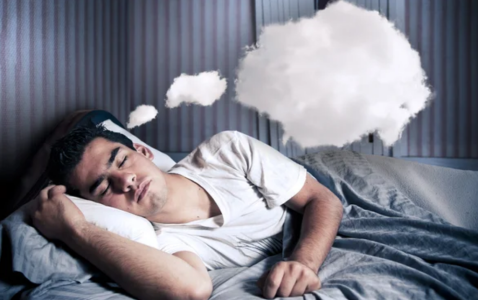Discover the Shocking Truth about Sexsomnia, Sleep Paralysis, and Other Mind-Bending Phenomena Scientists Have Uncovered!
By
Gian T
- Replies 1
Dreams are a universal human experience, a nightly journey into a world created by our minds. But what happens when the line between dreams and reality blurs, and our sleep is filled with anything but ordinary phenomena? Sleep patterns can change for many Australians over 60, and understanding these bizarre dream phenomena can be fascinating and important for our well-being.
Let's delve into the mysterious world of sleep and uncover the shocking truths about some of the most mind-bending phenomena scientists have encountered, like dream analyst and neurobiologist Jane Teresa Anderson.
**Sexsomnia: More Than Just a Bad Dream**
Sexsomnia, a type of parasomnia, is a condition where an individual engages in sexual acts while asleep. This rare disorder is often linked to stress and alcohol consumption and can be a side effect of certain medications. It predominantly affects men and can lead to significant confusion upon waking, not to mention the potential legal and consent issues that may arise. Understanding sexsomnia is crucial, especially if you or your partner have experienced anything similar. It's a reminder that our brains can do more than we can imagine, even in sleep.
**The Terror of Sleep Paralysis**
Imagine waking up, unable to move or speak, feeling an oppressive weight on your chest, and seeing a shadowy figure looming over you. This is the reality for about 7.6% of people who experience sleep paralysis. Occurring during the REM stage of sleep, where our bodies are essentially 'turned off' to prevent us from acting out our dreams, sleep paralysis can be a terrifying experience. Vivid hallucinations and a sense of dread often accompany it. While it's a harmless phenomenon, understanding it can alleviate the fear and anxiety associated with these episodes.
**False Awakenings: Dreams Within Dreams**
Have you ever dreamt that you woke up and started your day, only to wake up later and realise it was all a dream? These are false awakenings and can be disorienting, making you question what's real and what's not. They often occur during REM sleep and can be so vivid that you might not realise you're still dreaming until you truly wake up.
**Lucid Dreams: The Ultimate Virtual Reality**
Lucid dreaming is a state in which the dreamer is aware that they're dreaming and can sometimes control the dream's narrative. About one-fifth of people have experienced this heightened awareness, which can be exhilarating. Imagine flying through the skies or exploring fantastical landscapes, all within the confines of your mind. Lucid dreaming can be a source of creativity and problem-solving, as it allows you to explore the depths of your subconscious consciously.
**Hypnagogic and Hypnopompic Visions: The Threshold of Sleep**
As we drift off to sleep or start to wake up, we may experience hypnagogic or hypnopompic visions, respectively. These visual or auditory hallucinations occur on the edge of sleep, often involving strange images, patterns, or even the sensation of falling. These visions are a normal part of the sleep process and signify that your brain is transitioning to or from the dream state.
**Shared Dreaming: A Psychic Connection?**
One of the most intriguing phenomena is shared dreaming, where two people have similar or identical dreams on the same night. While this may sound like something a science fiction movie, it's often explained by shared experiences or strong emotional bonds, particularly among twins. It's a testament to the complex and interconnected nature of our minds.
**Navigating the Night**
Understanding these phenomena can help us navigate the night with more awareness and less fear. If you've experienced any of these occurrences, remember that they are common and, in most cases, harmless. However, discussing them with a healthcare professional is important if they're causing distress or affecting your sleep quality.
 At the Seniors Discount Club, we're curious about your nocturnal adventures. Have you ever experienced any of these dream phenomena? How did they make you feel, and what did you do about them? Please share your stories in the comments below, and let's unravel the mysteries of the night together.
At the Seniors Discount Club, we're curious about your nocturnal adventures. Have you ever experienced any of these dream phenomena? How did they make you feel, and what did you do about them? Please share your stories in the comments below, and let's unravel the mysteries of the night together.
Let's delve into the mysterious world of sleep and uncover the shocking truths about some of the most mind-bending phenomena scientists have encountered, like dream analyst and neurobiologist Jane Teresa Anderson.
**Sexsomnia: More Than Just a Bad Dream**
Sexsomnia, a type of parasomnia, is a condition where an individual engages in sexual acts while asleep. This rare disorder is often linked to stress and alcohol consumption and can be a side effect of certain medications. It predominantly affects men and can lead to significant confusion upon waking, not to mention the potential legal and consent issues that may arise. Understanding sexsomnia is crucial, especially if you or your partner have experienced anything similar. It's a reminder that our brains can do more than we can imagine, even in sleep.
**The Terror of Sleep Paralysis**
Imagine waking up, unable to move or speak, feeling an oppressive weight on your chest, and seeing a shadowy figure looming over you. This is the reality for about 7.6% of people who experience sleep paralysis. Occurring during the REM stage of sleep, where our bodies are essentially 'turned off' to prevent us from acting out our dreams, sleep paralysis can be a terrifying experience. Vivid hallucinations and a sense of dread often accompany it. While it's a harmless phenomenon, understanding it can alleviate the fear and anxiety associated with these episodes.
**False Awakenings: Dreams Within Dreams**
Have you ever dreamt that you woke up and started your day, only to wake up later and realise it was all a dream? These are false awakenings and can be disorienting, making you question what's real and what's not. They often occur during REM sleep and can be so vivid that you might not realise you're still dreaming until you truly wake up.
**Lucid Dreams: The Ultimate Virtual Reality**
Lucid dreaming is a state in which the dreamer is aware that they're dreaming and can sometimes control the dream's narrative. About one-fifth of people have experienced this heightened awareness, which can be exhilarating. Imagine flying through the skies or exploring fantastical landscapes, all within the confines of your mind. Lucid dreaming can be a source of creativity and problem-solving, as it allows you to explore the depths of your subconscious consciously.
**Hypnagogic and Hypnopompic Visions: The Threshold of Sleep**
As we drift off to sleep or start to wake up, we may experience hypnagogic or hypnopompic visions, respectively. These visual or auditory hallucinations occur on the edge of sleep, often involving strange images, patterns, or even the sensation of falling. These visions are a normal part of the sleep process and signify that your brain is transitioning to or from the dream state.
**Shared Dreaming: A Psychic Connection?**
One of the most intriguing phenomena is shared dreaming, where two people have similar or identical dreams on the same night. While this may sound like something a science fiction movie, it's often explained by shared experiences or strong emotional bonds, particularly among twins. It's a testament to the complex and interconnected nature of our minds.
**Navigating the Night**
Understanding these phenomena can help us navigate the night with more awareness and less fear. If you've experienced any of these occurrences, remember that they are common and, in most cases, harmless. However, discussing them with a healthcare professional is important if they're causing distress or affecting your sleep quality.
Key Takeaways
- Sleep phenomena such as sleep paralysis, hypnagogic and hypnopompic visions, lucid dreams, and false awakenings can make our dream experiences range from comforting to terrifying.
- Sleep paralysis is a particularly frightening state where a person is awake but unable to move or speak, often accompanied by distressing hallucinations.
- Lucid dreams are a state of heightened awareness where individuals realise they are dreaming and can sometimes control the dream's narrative.
- Parasomnias, such as sleepwalking and sexsomnia, involve physical activities performed while the brain is still in a sleep state, which can lead to complex legal and social issues regarding consent.








